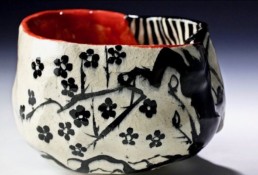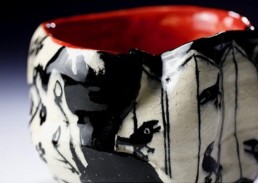A “Rose Oribe” Masterpiece by Suzuki Goro
Artist:Suzuki GoroEra:ContemporaryPrice:SoldInquire:info@shirakuragallery.com
One of the finest, most daring, and well-crafted works I have seen by this legendary artist who is known for his non-conformist and bold style. Suzuki Goro has outdone himself with this Rose Oribe ceremonial tea bowl. Oribe is a visual style named after the late-16th-century tea master Furuta Oribe (1544-1615). The most common types in this genre are Oribe-guro with jet-black glazes and feldspar ornamentation, Ao-Oribe with dark-green glazes, followed by the somewhat rarer type of Oribe known as Narumi-Oribe which can range from a reddish to a brownish color. All types tend toward the minimalistic, abstract; and, some would say, Zen-like aesthetic. Here Suzuki has expanded beyond the classic forms of this already non-conventional style to produce something utterly unique which he describes as “Rose Oribe.”
An exceptionally playful and skilled artist, Suzuki’s career as a potter began at the young age of 16. Like most Japanese potters he began by studying the classics, specifically Mino-ware from the Momoyama period over 400 years ago. Later he sojourned in the US where he broadened his style and moved away from the classics towards the more experimental and avant-garde. Suzuki claims to make pieces that “most people would never think to create” and continually strives to infuse uniqueness and vitality into everything he touches.
Over the years he has received many awards and accolades including the Japan Ceramic Society Prize. In addition he has served as a Visiting Scholar at Cranbrook Academy of Art, Michigan, and the Rhode Island School of Art and Design. His works are sought after by collectors both in Japan and abroad and examples of his pieces can be found in museums around the world including the Los Angeles County Museum of Art; the Denver Art Museum; the Metropolitan Museum of Fine Art; the Museum of Fine Art Boston; the Marer Collection, Scripps College; the Meito Art Museum; the Aichi Prefecture Ceramics Museum; and the Hetsens Museum in Germany among others.
This piece is 4.8 inches in diameter (12.2 cm) and stands 3.2 inches tall (8.2 cm). In excellent condition, it bears the artist’s signature on the base and comes with a sealed and signed box (tomobako). It also comes with a protective cloth (with seal) and an insert in Japanese detailing Suzuki’s career and gives some information on the kiln.










